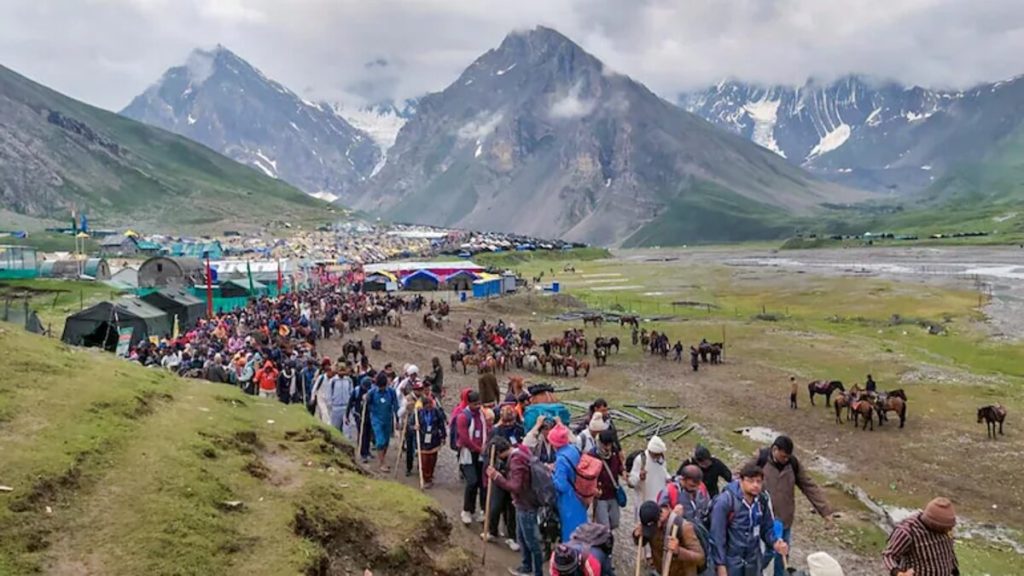Article: Environmental toll of militarization, pilgrimage in IIOJK
 Humayun Aziz Sandeela
Humayun Aziz Sandeela
On November 6, the International Day for Preventing the Exploitation of the Environment in War and Armed Conflict highlights the often-overlooked environmental costs of conflict. In the context of Indian-illegally occupied Jammu and Kashmir (IIOJK), environmental degradation has become a pressing issue exacerbated by ongoing militarization and significant infrastructure projects. For decades, Kashmir’s natural beauty has been at the mercy of geopolitical tension and large-scale military activities, which have impacted not only the region’s ecology but also the local population’s access to natural resources and traditional lands. Additionally, activities like the Amarnath Yatra, an annual Hindu pilgrimage, have introduced further ecological strains, with significant impacts on the environment.
Jammu and Kashmir is among the most militarized regions in the world, with an estimated 900,000 Indian troops deployed throughout the area. This heavy military presence consumes large tracts of land for military bases, outposts, and related infrastructure, causing disruption to the natural landscape. Forests are cleared, and watersheds are impacted, with minimal environmental accountability, often in the name of India’s ‘national security’. The construction of roads, bunkers, and defense infrastructure has resulted in deforestation and soil erosion, leading to the destabilization of ecosystems and increased vulnerability to landslides and flooding. These environmental consequences are often ignored in official reports, despite their long-lasting impacts on biodiversity and local communities.
The ecological consequences of military occupation extend beyond just the destruction of flora. Indian troop stationed in the occupied territory use substantial amounts of water resources for military installations, depleting freshwater sources that local communities depend on. Streams, rivers, and lakes, which once supported agriculture and provided drinking water, are now subject to contamination and overuse. Pollution from military camps further affects the quality of these water bodies, with waste disposal systems that often do not meet environmental standards, resulting in untreated waste being dumped into local water sources.
The significant land use by the Indian troops also impacts the local population, as communities are often evicted or restricted from accessing lands they traditionally depended on for agriculture and grazing. This displacement not only disrupts the social fabric of Kashmiri society but also undermines traditional farming practices that are crucial for the region’s subsistence-based economy. Families who once relied on these lands for their livelihoods are forced to move, losing their homes, access to resources, and means of survival. This forced dislocation exacerbates poverty, discontent, and social instability, with minimal compensation or rehabilitation offered to the displaced.
In addition to military exploitation, the Amarnath Yatra, an annual pilgrimage to a Hindu shrine in the Himalayas, presents its own set of environmental challenges. The Yatra, which attracts hundreds of thousands of pilgrims each year, requires substantial infrastructure and logistical support, including temporary shelters, sanitation facilities, and roads. The increased foot traffic, along with the construction of facilities to accommodate the influx of visitors, has led to significant ecological degradation. Each year, large amounts of waste, plastic, and non-biodegradable materials are left behind, polluting streams and forest areas surrounding the pilgrimage site.
The Indian government has prioritized infrastructure expansion to accommodate growing numbers of pilgrims, but this has come at the cost of fragile ecosystems. Glacial melt due to climate change has already made the region vulnerable, and the addition of constant human activity has only accelerated the rate of degradation. Environmentalists have warned that the area’s capacity for tourism has been exceeded, with alarming consequences for the unique flora and fauna that inhabit the region. Local residents express concerns over the environmental impact, but their voices are often sidelined in favor of religious and political interests.
On this International Day for Preventing the Exploitation of the Environment in War and Armed Conflict, it is essential to address the environmental implications of militarization and unchecked tourism in occupied Kashmir. Kashmir’s delicate ecological balance requires urgent intervention to halt further exploitation, and sustainable practices must be implemented to preserve its natural beauty for future generations. There is a pressing need for environmental impact assessments, waste management systems, and sustainable tourism policies that prioritize the region’s ecology over mass tourism.
International bodies and environmental organizations could play a pivotal role in holding India accountable for the ecological impacts of its military and tourism activities in Kashmir. Humanitarian efforts to mitigate environmental damage could also focus on engaging local communities in conservation efforts and providing them with the necessary resources to restore degraded landscapes.
The exploitation of Kashmir’s environment in the name of conflict and tourism highlights a broader issue: the denial of the environmental rights of the Kashmiri people. Protecting the environment should be seen as an extension of safeguarding human rights, as local populations depend on these ecosystems for survival. Observing the International Day for Preventing the Exploitation of the Environment in War and Armed Conflict serves as a reminder that war’s toll is not limited to human lives but extends to the very landscapes that sustain those lives.
Ending military occupation and implementing regulated tourism could pave the way for sustainable development in occupied Kashmir. The path to preserving Kashmir’s environment must include demilitarization, comprehensive environmental regulations, and policies that respect both nature and the rights of the Kashmiri people. As the world observes this day, it is imperative to advocate for a sustainable and just solution for Jammu and Kashmir, one that honours its landscapes, people, and future.








